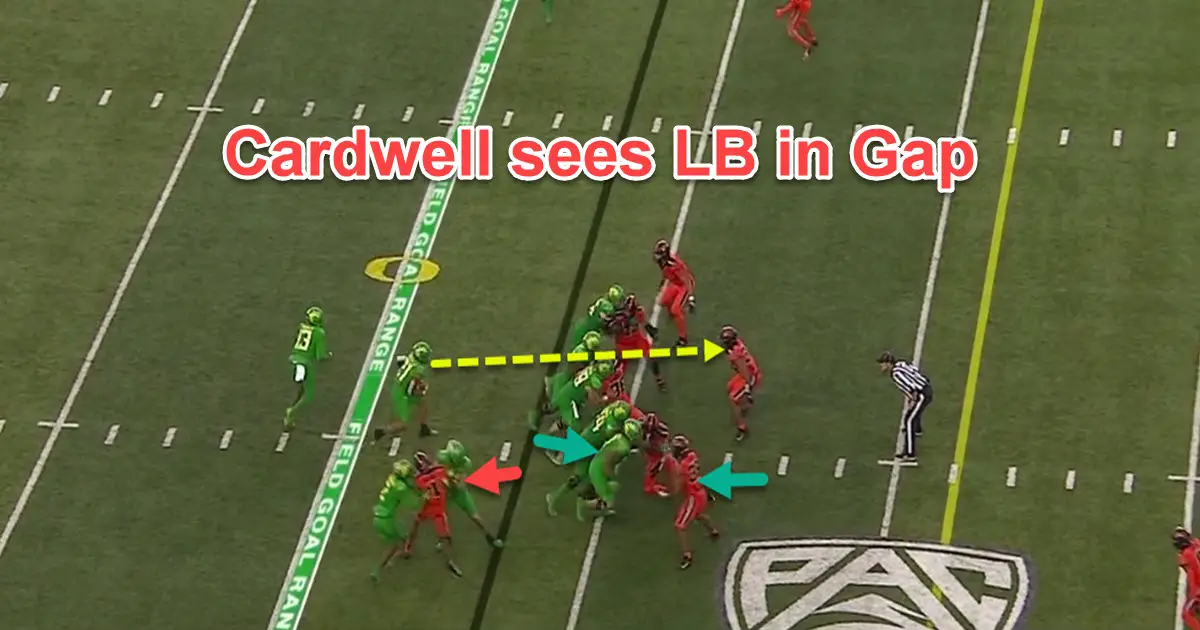One of the biggest bones of contention the fans have had with the Mario Cristobal era of nearly four years was pounding of the “A” gaps with the “Plodding-Pistol” formation. Late last year we began to see more of the Shotgun formation, and less of the Pistol to where now we simply do not see the Pistol formation at all. This does not mean that pounding the “A” gap as ceased, but it has become much more successful with the introduction of the Shotgun formation Inside Zone introduced by OC Joe Moorhead.
Cristobal loves to impose his will with the Inside Zone, but noting the success via the Shotgun–has allowed Coach Moorhead to pound the “A” gaps his way with the Shotgun Inside Zone he brought from Penn State and Mississippi State. (We covered it last summer right here) Keep in mind that this concept is not new, but in fact here is an analysis from yours-truly seven years ago that still gets big pageviews from high school coaches referring it to their running backs.
The reason for the update is because I am excited about all the yardage, and even explosion plays coming from this “matured” base play in the Oregon offense. Why the better results? It is due to the offensive line and running backs becoming adjusted to this new (to them) mode of running Inside Zone, as I am seeing precise timing by the offensive linemen and great blocking reads by the running backs that were not present before. Let’s learn some more football!
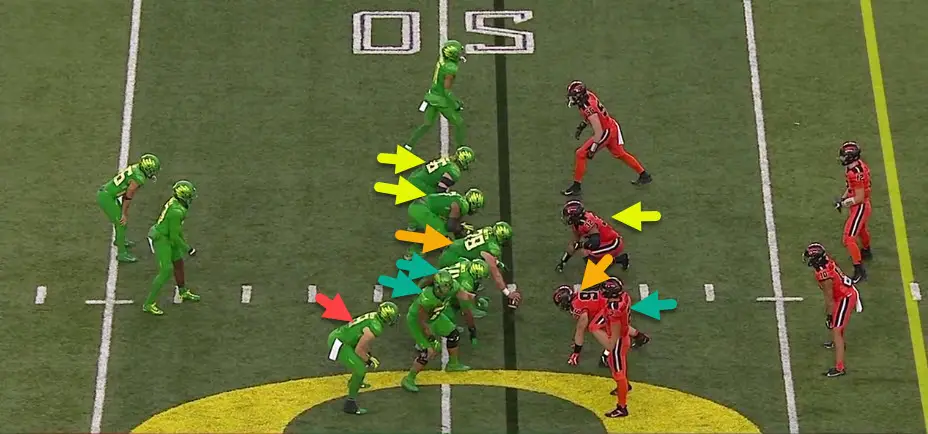
Check the blocking assignments to see how it develops.
Getting ready for a Shotgun Inside Zone–note how in the video that Travis Dye (No. 26 running back) will take a side-step toward the quarterback and be headed for the “A” gap, but can read the blocks and adjust. The lemon colored arrows above on the Oregon side point to TJ Bass No. 56 (upper one) and George Moore No. 77 (lower one) who will double-team the OSU defensive tackle No. 32, who will be slanting to his right as all the Beavers will be on this play.
The orange arrow is pointing to No. 78 Alex Forsyth and the OSU defensive lineman who will be slanting into him. (Orange is now a benign color) The two green arrows above point (upper) to No. 74 Steven Jones, and the lower one is pointing to Malaesala Aumavae-Laulu No. 71 (Sala) and he is telling the tight end No. 19 Terrance Ferguson (red arrow above) to block the safety coming up, No. 28 of the Beavers who is not in the picture yet. Note we have five offensive linemen and a tight end to block the six Oregon State defenders in the box. Seems even?
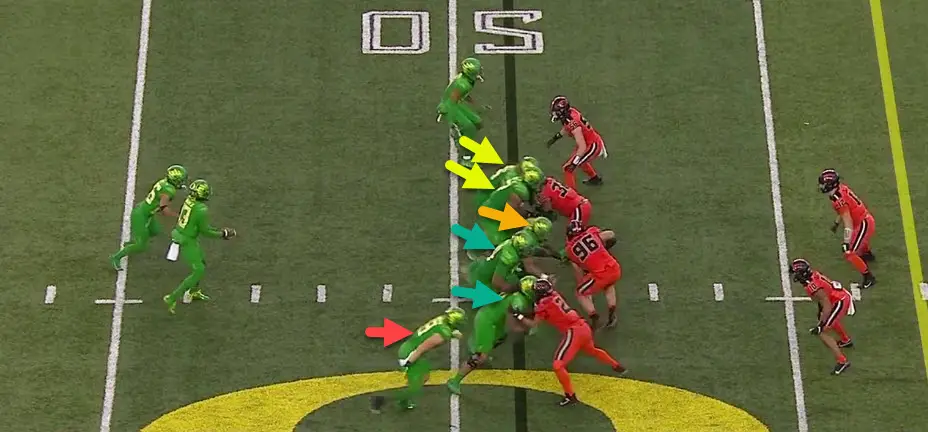
The blocks are forming before a handoff is even made!
The blocks are beginning as planned, note the upper green arrow, Steven Jones was checking to be certain No. 96 of OSU was slanting inside, thus he could help on the combo block on the outside with Sala. (Lower green arrow) The Beavers linebackers are back there and ready to plug any gap Travis Dye chooses.

Dye has to “bend” it!
It appears that this might not be an Inside Zone, but a Dive play Coach Boles explained last summer. Both plays attack the “A” gaps as Cristobal prefers, and the Zone blocking assignments remain the same. Note how Dye has planted his foot to push off because he sees the Beaver linebacker (dotted yellow line) set up in the gap he wanted to run into. Thus he is going to cut to the right or “bend” the play.
Both sides of the line of scrimmage (green arrows above) have the OSU defensive linemen smothered, and note how Ferguson (red arrow above) notices the safety coming up as Sala said, and he will go out to block him. The inside linebacker of the Beavers (pink arrow above) has his arm out anticipating a lineman about leave the combo block and come after him. (He was right)
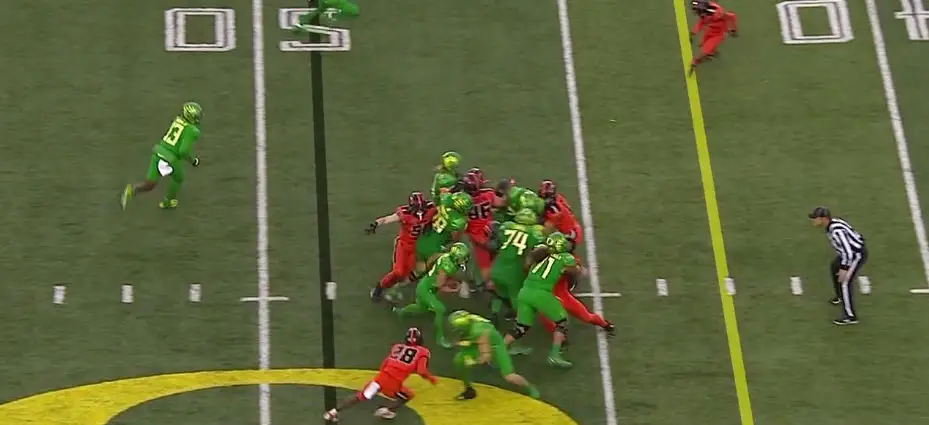
The “Green Wall of Cristobal” caves the Beavers in…
Sala (No. 71) left the combination block at the perfect instant to obliterate the OSU linebacker and create a beautiful “Green Wall of Cristobal” between Forsyth, Jones and Sala. Ferguson is blocking out the OSU safety No. 28, and a superb running lane is created for Dye who runs for 15 yards on a basic play wonderfully blocked by the Oregon offensive line.
Watching those blocks form is truly a thing a beauty to an old offensive tackle like yours-truly. The only thing better than watching an Inside Zone go 15 yards is seeing another go twice that distance!
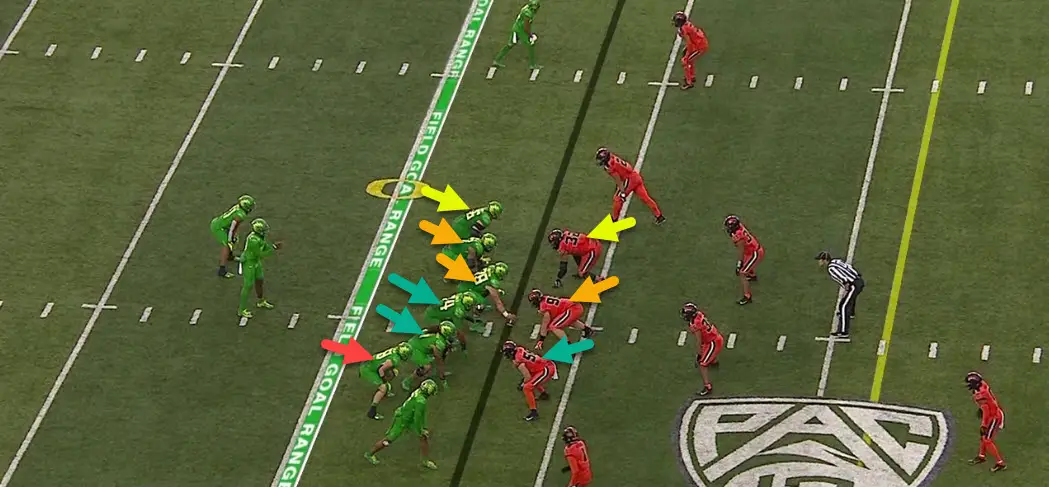
Check the blocking assignments before the action.
This Inside Zone above is against a defense that is not slanting, and these double-team combo blocks will occur against the defenders lined up in front of the Oregon offensive linemen. The color of arrows are matched with OSU defensive linemen who will be blocked, and this time the red arrow above pointing to the tight end is Spencer Webb, No. 18.
While there are six defenders in the box–you have two other Beavers quite close as they correctly anticipate another running play coming at them. Is Oregon outnumbered and outmanned on this play?
——————————————————————————————–
The Our Beloved Ducks Forum is BACK! Come get the links to Oregon Sports articles, the press releases from the Oregon Athletic Department and the news from your fellow Duck fans. It is the only safe place on the web for Duck Discussion, such as today’s article, so join us over there!
——————————————————————————————–
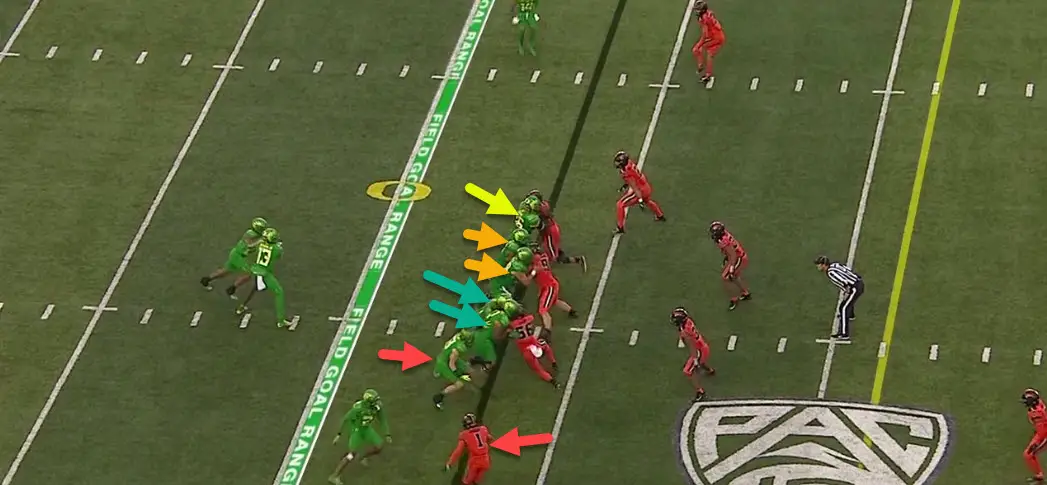
Things are progressing well thus far…
At the mesh-point above, the quarterback is checking the outside linebacker, and since he is sitting and thus blocking a running path for No. 13 Anthony Brown, the correct read is to hand-off to No. 21 Byron Cardwell. Sure enough we see TJ Bass (top lemon arrow) handling his defender well.
The Oregon double-teams of the orange and green arrows above are in command and beginning to take control of the line of scrimmage. The lower green arrow, Sala, will move to the linebacker in a fraction of a second since Jones has control of the defensive lineman of OSU, No. 56. The red arrow of Webb points to how he notices the safety coming up and he prepares to pivot to block him.
Beaver linebackers are hovering and ready to pounce into the gap Cardwell attacks.
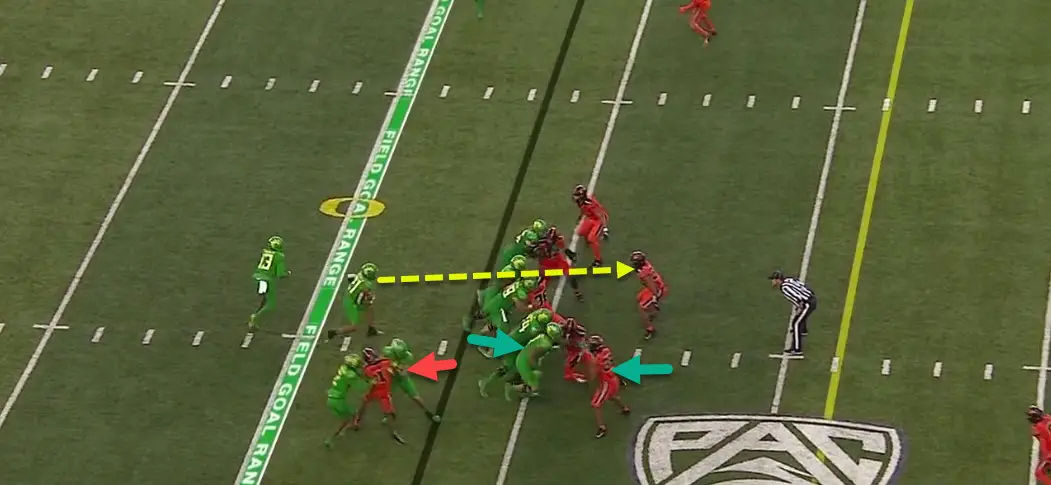
That Beaver linebacker is right there in the gap Cardwell wants!
Note how Cardwell sees the OSU linebacker in the “A” gap he wants to run in, and thus he has planted his foot to bend the other direction. Oregon’s tight end, Spencer Webb, (red arrow) is blocking the onrushing safety with wide receiver Devon Williams No. 2. Note the green arrows as Sala is finishing the double-team and taking aim on the linebacker in front of him.
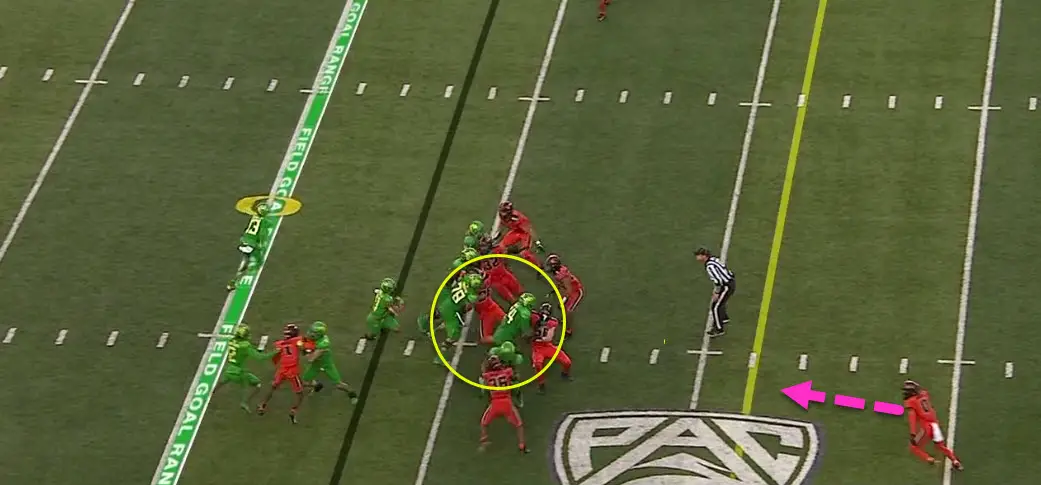
Perfect timing to create a running lane for Cardwell!
Wow. These are real-men blocking above, as No. 78 Forsyth has control of his defender as does No. 74 Jones. Sala left the combo block at the precise instant to block and move the Beaver linebacker No. 36 outward, which then creates a perfect running lane that Cardwell is headed toward. Please note that the play was not designed this direction, but they carried out their blocks in case the running did cut-back or “bend” the Inside Zone.
The Beaver safety above (pink arrow) is coming up to the open gap, but as he approaches is trying to position himself to cover all directions Byron could cut. As it turns out–Cardwell has extraordinary instant-acceleration, and thus blows to the right and down the sideline.
Who would have thought that a basic play, the Inside Zone, could create an explosion play? When it is this well blocked and with defenders tiring–big plays can happen. At the time, there were four minutes left and Oregon was only up by ten points and needed to score, while the Beavers needed to stop Oregon…and could not.
When you watch the videos, note the amazing timing that the Oregon offensive linemen have perfected with their combo blocks, moving to the linebacker at the next level, and at the right moment to create a lane for the running back following them. Next year this offensive group will be quite savvy and experienced, thus gets us to thinking because…
“Oh, how we love to ponder about Our Beloved Ducks!”
Charles Fischer (Mr. FishDuck)
Eugene, Oregon
Top Photo from ESPN Video
Come join us in the new Our Beloved Ducks Forum, where you get the news about Oregon Sports and is the safest place on the web to read and post your opinions!

Charles Fischer has been an intense fan of the Ducks, a season ticket holder at Autzen Stadium for 38 years and has written reports on football boards for over 26 years. Known as “FishDuck” on those boards, he is acknowledged for providing intense detail in his scrimmage reports, and in his Xs and Os play analyses. He is single, has a daughter Christine, and resides in Eugene Oregon where he was a Financial Advisor for 36 years.
He now focuses full-time on Charitable Planned Giving Workshops for churches and non-profit organizations in addition to managing his two Oregon Football Websites, of FishDuck.com and the Our Beloved Ducks forum. He is a busy man!
He does not profess to be a coach or analyst, but simply a “hack” that enjoys sharing what he has learned and invites others to correct or add to this body of Oregon Football! See More…

